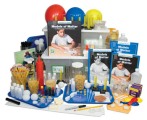11 Guidelines for Teaching with Discourse Circles
October 10, 2013 at 7:43 pm Leave a comment
Discourse circles involve students in structured, evidence-based conversations around challenging statements. This article provides guidelines that can be used to conduct a discourse circle in conjunction with many science texts.
Here is a quick overview of how the discourse circle will work:
11 Guidelines for Teaching with Discourse Circles
- Select a text that provides evidence both for and against a statement. In science, good choices include books about human impact on the environment, books that mention scientific debates, and books about the history of science.
- Craft a statement for which students can find evidence to both support and contradict it. Write the statement on a Preparing for a Discourse Circle copymaster (PDF sample below) and make a copy for each student. The following are some guidelines to use when writing discourse-circle statements:
∙ The text must provide evidence both for and against the statement.
∙ The statement should not be obviously true or obviously false.
∙ Students should be able to choose either position without developing misconceptions about the topic.
∙ The statement should relate to important concepts in the text.Here are two examples of discourse-circle statements:
Students like us can help prevent oil from spilling in the ocean.
The stomach is the most important organ in the digestive system. - Make a class chart titled “Discourse-Circle Directions” that lists the directions for a discourse circle. (See the box above.)
- Have students read the book you have selected, focusing on the content of the book.
- Tell students they will be having a special discussion called a discourse circle that will focus on evidence they gather from the text they just read. Explain that the evidence will be both for and against the statement. Present the discourse-circle statement to the class.
- Have students reread the text, noting evidence to support and contradict the statement on their Preparing for a Discourse Circle student sheets.
- Ask students to now consider the evidence they have gathered and decide whether they are for or against the statement. Form small groups comprised of students who agree and students who disagree with the statement.
- Go over the Discourse-Circle Directions class chart, making sure that students understand what to do. Explain that scientists often change their ideas when they learn about new evidence, and that students may want to do the same. Also point out that scientists may disagree with each other, but they do so respectfully. (You may wish to model this for students.) The purpose of the discourse circle is not to decide whether the statement is right or wrong; the purpose is to consider as much available evidence as possible about an important idea.
- Students conduct discourse-circle discussions as described on the Discourse-Circle Directions class chart.
- As a class, debrief the discussion. Talk about how the discourse circle went, emphasizing how students used evidence from the text to support their ideas. Discuss the statement and generate a consensus statement on which all students agree.
- Continue using discourse circles as a way for students to discuss their ideas. Over time, they will become better at conducting discourse circles and will gain proficiency using evidence to support their ideas.
Click here to download the Preparing for a Discourse Circle copymaster.
For more information about Seeds of Science/Roots of Reading Strategy Guides, covering a variety of powerful instructional strategies from the Seeds of Science/Roots of Reading integrated curriculum, visit http://www.scienceandliteracy.org/teachersupport/strategyguides
Do you want to be notified when we publish new blog articles? Simply enter your email address in the “Follow Blog via Email” box located in the right sidebar.
Entry filed under: Informational text, Strategy Guide. Tags: discourse circles, elementary curriculum, elementary lesson plans, literacy.





Trackback this post | Subscribe to the comments via RSS Feed